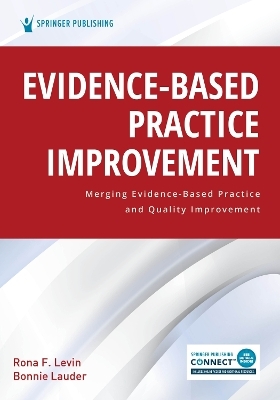
Evidence-Based Practice Improvement
Springer Publishing Co Inc (Verlag)
978-0-8261-8213-5 (ISBN)
This unique text provides the academic and clinical healthcare communities with a tested, practical, and successful model (EBPI+) to steer evidence-based practice improvement projects. The model--tested in multiple clinical settings--is distinguished from similar prototypes by its integration of the best EBP and quality/performance improvement principles (QI), resulting in a highly practical and comprehensible model for guiding students' and clinicians' work to improve quality outcomes in healthcare.
The book emphasizes the need for collaboration among all stakeholders, particularly those in different disciplines with different perspectives, to provide greater clarity and enhance improvement work in a clinical agency. It features a blueprint for guiding healthcare improvements based on evidence that incorporates potential changes of direction midstream. The book also introduces tools for the evaluation of organizational commitment, stakeholder choice, and sustainability of improvement projects. Section One of the text focuses on the background and development of the original EBPI model, followed by, in Section Two, an elaboration of the components of the new enhanced model, EBPI+. Chapter authors in Section Three describe how they used the components of the EBPI model, discussing lessons learned from its use. This section, connecting the theoretical basis for this work with real-world applications, includes a template that readers can use to facilitate their own projects. The final section investigates future approaches to improvement work. Comprehensive appendices provide useful tools for students and clinicians to use in developing, implementing, and evaluating any EBPI+ projects. Purchase includes online access via most mobile devices or computers.
Key Features:
Describes a practical and successful model incorporating the best of EBP and QI approaches (EPBI+) for improving quality outcomes in healthcare
Incorporates a strong focus on how to determine and engage project stakeholders and provides tools for effective decision making
Delineates specific methods to develop protocols for a small test of change prior to larger pilot studies
Delivers approaches/strategies for monitoring and evaluating sustainability
Discusses how to assess organizational commitment and conduct stakeholder analyses
Creates examples that use each component of EBPI+ as a template for readers
Emphasizes the "how to" of implementation more than other competitive models
Rona F. Levin, PhD, RN, is internationally recognized for her work in evidence-based practice improvement. In 2015, Sigma Theta Tau International presented her with their Evidence-Based Practice Award. She and co-editor, Dr. Harriet Feldman, won AJN Book of the Year Awards for the first (2006) and second (2013) editions of Teaching Evidence-Based Practice in Nursing published by Springer. Dr. Levin, now in a preferred state (semi-retired), practiced in almost every clinical service at the beginning of her career. In 1968, she developed the idea for and implemented as the nurse manager a new unit at then Long Island Jewish Hospital, known as self-directed patient care, which embodied all the components of evidence-based nursing practice, integrating evidence-based care with patients values and goals, and her clinical experience and caring, before EBP became the by-word for nursing practice. Bonnie Lauder, RN, PMHNP, MIS, CPHQ, is the Vice President of Operations at the VNS HEALTH Hospice. She received her Bachelor of Science in Nursing from State University of New York Downstate and a Master's in Information Systems from Pace University. She has been a Certified Healthcare Professional in Quality (CPHQ) since 1992 and has a certificate in Population Health from Duke University. She became Psychiatric Mental Health Nurse Practitioner in 2020. She has 25 years of experience in the field of health care informatics and quality, having started her career at Mount Sinai Hospital where she established the first clinical information systems department. Since 2005, she has successfully designed and implemented core clinical and management delivery systems across hospital, home care, and hospice continuums using the Institute for Healthcare Improvement's Collaborative Model for Achieving Breakthrough Improvement and triple aim methodology of improving quality, reducing cost, and increasing access to healthcare services.
Contributors
Preface
Foreword by Bernadette M. Melnyk
Section I Introduction: Introduction and Background
Introduction to Section I
Chapter 1: EBP, QI, Translational Research, and Implementation Science
Chapter 2: History of Evidence-Based Practice and Quality Improvement Models
Chapter 3: The EBPI+ Model: Testing and Evolution
Section II: Description of EBPI+ Model
Introduction to Section II
Chapter 4: Principles of Organizational Commitment and Mentoring
Chapter 5: Area of Interest & Assessing Context
Chapter 6: Stakeholder Engagement
Chapter 7: Description of Clinical Initiative: Understanding Internal and External Data
Chapter 8: Description of Clinical Initiative: GAP Analysis and the Focused Clinical Question (FCQ)
Chapter 9: The EBPI+ Model Search for Evidence: Mapping the Journey
Chapter 10: Appraise and Synthesize the Evidence
Chapter 11: PDSA I: Developing Aim/Goal Statements and Implementing the Improvement
Chapter 12: PDSA II: Select Approaches to Studying the Improvement
Chapter 13: Evaluate Sustainability
Chapter 14: Dissemination
Section III: Testing of the EBPI Model
Introduction to Section III
Chapter 15: Implementing an Evidence-Based Protocol for Propofol Administration in Vented ICU Patients: Improving Patient Outcomes and Decreasing Hospital Costs
Chapter 16: Cesarean Surgical Site Infection Practice Improvement Project
Chapter 17: The Influence of Clinical Decision Support on Diagnostic Accuracy in Nurse Practitioners
Chapter 18: The Teach-Back Project: Improving Hospice Care
Chapter 19: Falls Project
Chapter 20: Enhanced Recovery after Surgery (ERAS)
Section IV: The Future of Evidence-Based Improvement
Introduction to Section IV
Chapter 21: Nursing in 10 Years? The Clinical Perspective
Chapter 22: Improvement Science in Ten Years: The Academic Perspective
Chapter 23: EBPI in 10 Years: A Business Perspective
Glossary
| Erscheinungsdatum | 06.04.2024 |
|---|---|
| Zusatzinfo | 5 Illustrations |
| Verlagsort | New York |
| Sprache | englisch |
| Maße | 178 x 254 mm |
| Gewicht | 835 g |
| Themenwelt | Pflege ► Studiengänge ► Pflegewissenschaft |
| ISBN-10 | 0-8261-8213-5 / 0826182135 |
| ISBN-13 | 978-0-8261-8213-5 / 9780826182135 |
| Zustand | Neuware |
| Haben Sie eine Frage zum Produkt? |
aus dem Bereich


